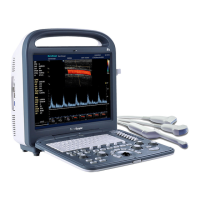S2/S2BW
Digital Color Doppler Ultrasound System
2.9 Transducer Maintenance
The transducers/probes provided with the system are durable and have reliable performance. These precision
instruments should be inspected daily and handled with care. Please observe the following PRECAUTIONS:
• Do not drop the transducer on the hard surface. This can damage the transducer elements
and compromise the electrical safety of the transducer.
• Avoid kinking or pinching the transducer cable.
• Use only approved ultrasound coupling gels.
• Follow the instructions for cleaning and disinfecting the probes.
Disinfecting Surface Transducers
• Disconnect the transducer from the system.
• Wipe all surfaces with isopropyl alcohol solution and air dry.
• Clean all surfaces of the probe and cable with soft cloth.
• Allow the transducer to air dry prior to storage or further use.
The following statement from AIUM outlines instructions for cleaning the intracavitary transducer:
Guidelines for Cleaning and Preparing Endocavitary Ultrasound Transducers between
Patients from AIUM
Approved June 4, 2003
The purpose of this document is to provide guidance regarding the cleaning and disinfection
of transvaginal and transrectal ultrasound probes.
All sterilization/disinfection represents a statistical reduction in the number of microbes present
on a surface. Meticulous cleaning of the instrument is the essential key to an initial reduction of
the microbial/organic load by at least 99%. This cleaning is followed by a disinfecting procedure
to ensure a high degree of protection from infectious disease transmission, even if a disposable
barrier covers the instrument during use.
Medical instruments fall into different categories with respect to potential for infection trans-
mission. The most critical level of instruments are those that are intended to penetrate skin or
mucous membranes. These require sterilization. Less critical instruments (often called “semi-
critical” instruments) that simply come into contact with mucous membranes such as fiber optic
endoscopes require high-level disinfection rather than sterilization.
Although endocavitary ultrasound probes might be considered even less critical instruments
because they are routinely protected by single use disposable probe covers, leakage rates of
0.9% - 2% for condoms and 8%-81% for commercial probe covers have been observed in recent
studies. For maximum safety, one should therefore perform high-level disinfection of the probe
between each use and use a probe cover or condom as an aid in keeping the probe clean.
There are four generally recognized categories of disinfection and sterilization.
Sterilization is the complete elimination of all forms or microbial life including spores
and viruses.
Disinfection, the selective removal of microbial life, is divided into three classes:
• High-Level Disinfection -Destruction/removal of all microorganisms except bacterial spores.
• Mid-Level Disinfection - Inactivation of Mycobacterium Tuberculosis, bacteria, most viruses,
fungi, and some bacterial spores.
• Low-Level Disinfection - Destruction of most bacteria, some viruses and some fungi. Low-
level disinfection will not necessarily inactivate Mycobacterium Tuberculosis or bacterial
spores.
P/N: 4710.00149A01
2-10

